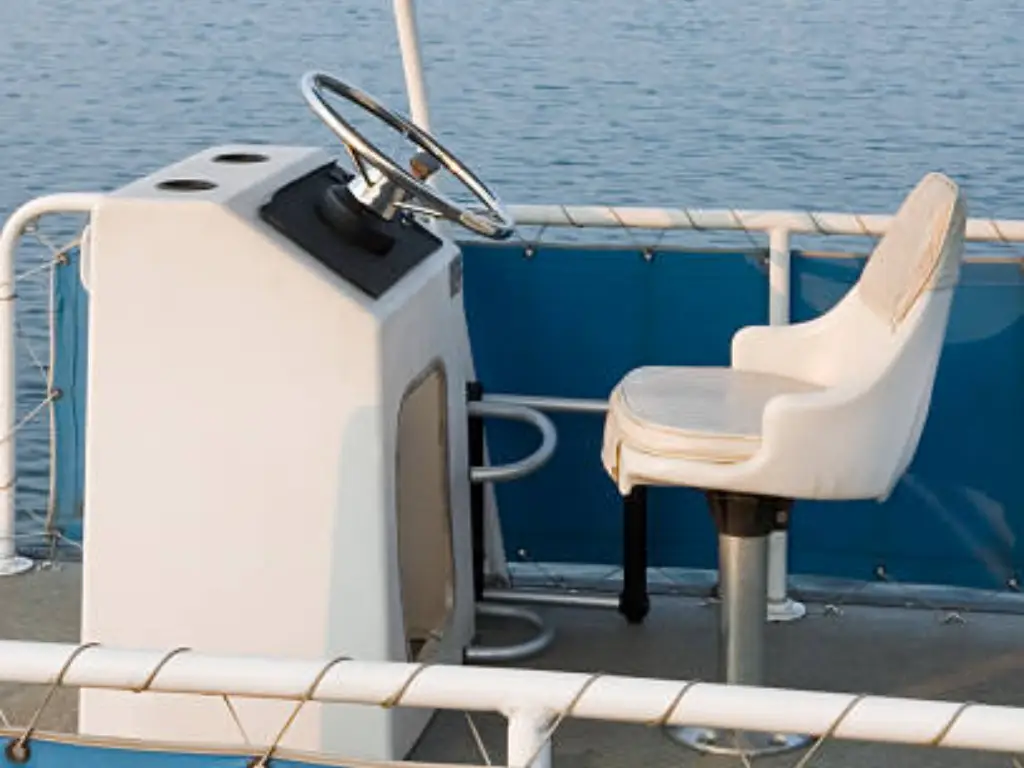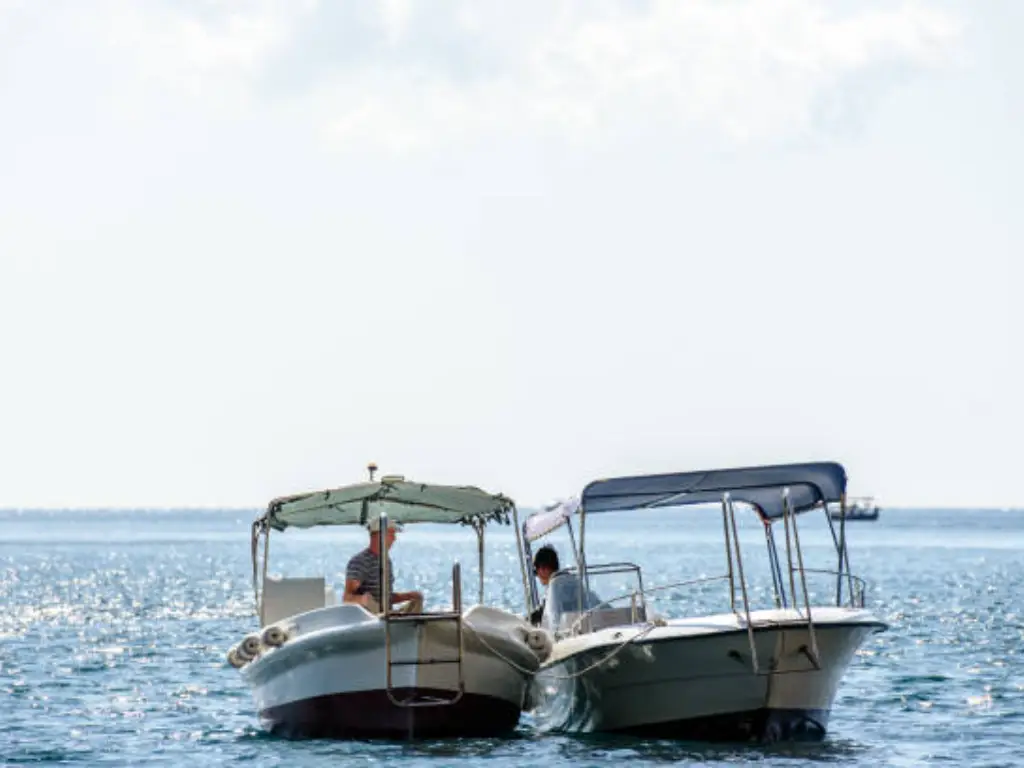การแนะนำ
Pontoon boats are a good choice for beginners because they are stable, comfortable, and easy to use. Even so, operating this type of boat safely requires you to know the basics, be prepared, and respect the water. While cars are not affected by the weather, boats must deal with changes in wind, current, and waves.
It is essential to know how to operate your boat safely, whether you are out with your family or cruising in deep water. This guide will teach you how to check your boat’s safety, start the engine, use the throttle, steer, and dock the boat. You will also be taught how to deal with choppy waters, avoid common pitfalls, and build confidence as a beginner.
If you follow these steps, you’ll gain the ability to handle your boat safely and comfortably, knowing where you are and how to get to your destination. Once you’ve mastered driving, you can focus on the fun, like creating the perfect pontoon boat fishing setup for a relaxing day on the water.

What Makes Driving a Pontoon Boat Unique?
Unlike other boats, pontoon boats have a flat deck on hollow aluminum tubes (pontoons), making them very stable when the water is calm. While this classic two-tube design is popular, it’s worth understanding the differences between a tritoon vs pontoon for handling and performance. Because of this stable design, pontoon boats are less likely to rock and tip, which helps new boaters a lot
Pontoon boats are different from V-hull boats because they steer using the outboard motor at the back, much like a car. To turn, you need to use the throttle to power the motor and use the steering wheel to turn the stern. Therefore, drivers use slow, wide turns and brief bursts of power to control their movements, mainly when driving slowly.
Pontoon boats are a good choice for beginners since they are stable, move slowly, and handle well in calm weather. Yet, because they have a wide surface, they are more easily affected by wind and current, so new drivers should plan and adjust their course early.
Safety Checklist Before You Start the Engine
It is important to check for safety before you leave, as it helps ensure the safety of all the people on board. Make sure to check these main points before you start the engine on your pontoon boat:
1. ความปลอดภัย อุปกรณ์: Make sure every person on the boat has a life jacket that fits well and is in good condition and easy to reach. Check that the fire extinguisher is charged, has not expired, and is stored in a place you know. You should have a horn or whistle and working navigation lights, since they may be required by law in your area.
2. Engine and Fuel Inspection: Be sure that the boat has enough fuel for your trip, and some extra fuel in case you need it. Turn on the engine for a moment to see if it ignites smoothly and if there are any strange noises. Check fuel lines and the propeller for any damage or leaks that you can see.
3. Kill Switch Connection: Be sure to attach the emergency engine shut-off lanyard (kill switch) to yourself before you start your journey. The safety feature stops the engine if the operator is thrown from the helm, so the boat does not run out of control.
4. Deck and Hull Check: Ensure that all hatches are properly closed and locked. Make sure that fenders and dock lines are securely tied. Take away any items that are loose on the deck to prevent them from causing accidents during movement. Check the area around the propeller to make sure there is nothing caught in it.
5. Weather and Legal Readiness: Look at the latest weather and wind forecasts to stay safe during your trip. Make sure you have your boat license or proof of finishing a boating safety course, if the law requires it.

How to Start and Operate the Pontoon Boat
When you have finished your pre-departure tasks, you can start moving the boat. It is easy to start and use a pontoon boat, but being careful will help you have a safe and smooth launch.
- 1. Starting the Engine: Put the key into the ignition and turn it to get the engine running. When you start the motor, look at your dashboard gauges to confirm that battery voltage, oil pressure, and engine temperature are normal. Place the throttle in neutral before you begin the engine.
- 2. Preparing to Depart: Wait until everyone is seated and safe before moving the boat out of neutral. Check that all dock lines are loose and the fenders are inside the boat. Look around the boat to make sure there are no swimmers, obstacles, or other boats nearby.
- 3. Shifting into Gear: When the engine is running well, move the throttle control lever forward for forward gear or backward for reverse. Never make sudden changes in gears, as this could put extra stress on the engine and scare your passengers.
- 4. Leaving the Dock: Gently open the throttle in short bursts to move away from the dock. Don’t use the maximum power setting right away. Instead, turn the wheel slowly, so the boat can react at a low speed. Pontoon boats are very easy to steer at low speeds when the water is calm.
- 5. Building Speed Safely: When you are far enough from the dock and out in the water, gradually increase the speed to reach your cruising level. Check if the boat stays level and does not tip over. If the boat suddenly speeds up, the bow may rise too high and make the water choppy for those around you.
- 6. Keep an eye on your surroundings: Be aware of what is happening around you. Be aware of floating objects, people swimming, other boats, and shallow water areas of the water. Because pontoons do not have brakes, make sure to slow down and turn gradually before reaching your destination.
Step-by-Step: How to Drive a Pontoon Boat for Beginners
It takes time to get used to driving a pontoon boat, but once you learn the basics, it becomes easy. Here’s how you can boost your confidence when you’re at the helm:
1. Shift into Gear Smoothly: Once the engine is running and the path ahead is clear, move the throttle lever forward or backward to go in the direction you want. Try to move the boat slowly and smoothly, as this is best for pontoon boats at low speeds.
2. Apply Gradual Throttle: Raise your speed gradually. Gently increase the throttle to help the bike gain speed. Pontoon boats build up speed slowly and can be moved with just a little power. If you begin at a high speed, the wake may be too strong for passengers to stay balanced.
3. Practice Basic Turning: Use the steering wheel to turn the boat right or left. When you move the boat slowly, it will react steadily. Begin by making large, careful turns to see how much space you need to turn. Unlike a car, you can’t stop right away, so decide your route ahead of time.
4. Adjust the Bow (Front) Direction: When the bow is being pushed off course by wind or current, make small adjustments to your steering. Making small adjustments is more useful than trying to steer too much. It helps to always look ahead for a landmark or marker to guide your progress.
5. Maintain Control in Open Water: Once you are in the open water, slowly increase your speed to the cruising level. Keep your hand steady on the wheel and do not change the throttle too much. Do not make sharp turns when you are going fast, because pontoon boats are not designed for quick maneuvers.
As you practice often, these basic movements will become easy for you. Be aware of your surroundings and change your driving style according to the weather, boats nearby, and how visible things are.

How to Dock a Pontoon Boat
To dock a pontoon boat, you should control your movements, pay attention to your surroundings, and use the throttle correctly. Even though pontoon boats are usually steady, their broad shape and extra windage can make docking difficult if you don’t have a plan. The following guide explains the main docking situations and the techniques used.
1. Side Docking (Parallel Dock)
Come to the dock by turning the boat at a 20–30° angle while it is at idle. When the boat gets close to the dock, decrease the speed and use reverse for a short time to slow down. Steer the boat’s stern to move it alongside the dock.
- Wind Consideration: Approach into the wind if possible for better control.
- Throttle Use: Apply short, precise bursts instead of constant acceleration.
- Crew Coordination: Place lines and fenders on the side of the boat facing the dock.
2. Slip Docking (Between Pilings)
Position the boat early and go at low idle to avoid drifting. The aim is to guide the boat to the middle of the slip using only slight changes in steering.
- Neutral Gear: Use the Neutral Gear often to prevent yourself from oversteering.
- Fender Placement: Place fenders on both sides because there is not much space.
- Throttle Adjustment: If you are about to overshoot the alignment, use reverse to slow down.
3. Reverse Throttle Control
Reverse gear is important for handling at low speeds, especially when you need to make small adjustments at the end.
- Engage reverse in short pulses to slow forward motion.
- Before reversing, turn the wheel to steer the stern properly.
- Ideal for correcting minor misalignment during the final docking phase.
4. Twin-Engine Pivot Maneuver (if equipped)
Pontoon boats with two engines can make a tight turn without using the wheel.
- Move one engine forward and the other engine backward.
- Turn the boat in this way to get it in line with a dock or to fit into a small space.
- They are especially helpful when you have a narrow or windy slip.
5. Solo Docking
If you are docking by yourself, you should always be prepared.
- Make sure the fenders are fastened and the dock lines are already tied to the correct side.
- Secure the bow line with a boat hook before you secure the stern.
- Try to dock your boat where the wind or current is not strong.
Docking might seem simple, but once you’re at the helm, it often brings unexpected challenges. The following video gives you a step-by-step look at how to dock a pontoon boat with confidence. You’ll see how to approach the dock slowly, control your speed with reverse gear, and keep everything smooth and safe. It’s perfect for beginners or anyone looking to reinforce the basics of boat handling.
Floating plastic docks are convenient and need little upkeep for pontoon boats. Because they are made of tough polyethylene or similar materials, these docks are not affected by corrosion, UV rays, or changes in water levels. Because they are modular, they can be arranged in different ways to suit many types of waterfront areas. Floating docks adjust to the water level, so they always stay at the same height, which is helpful for pontoon boats with level decks and broad beams. As a result, they are suitable for both personal and business purposes.
Find the Best Plastic Floating Dock System in Hisea
Hiseadock has over 10 years of manufacturing experience and services in more than 80 countries and regions worldwide. With state-of-the-art manufacturing facilities, including over 5,000 square meters and four state-of-the-art production lines, as well as special equipment such as large rotomolding and blow molding machines, Hiseadock is able to achieve quick shipment of standard products (7-10 days of production without inventory) and lead times of approximately 10-15 days for custom orders.
















Driving a Pontoon Boat in Wind, Current, or Rough Water
Pontoon boats are most comfortable in still waters, but wind, current, and waves can make them handle differently. It is important to understand how these forces affect the boat’s flat-deck and high-windage design to keep the boat under control and safe.
1. Wind Handling
Crosswinds can easily affect pontoon boats because they have a wide surface and are light, especially when moving slowly.
- Turn more sharply toward the dock (30–45°) to deal with lateral drift.
- Make quick throttle movements to fix your direction; don’t keep the throttle pressed down all the time.
- If the wind is strong, it is best to tie up on the side facing the wind or wait for the wind to calm down.
2. Navigating in Current
In these areas, the current may help you move or make it harder for you to move. Pontoons are more likely to be affected by waves than deeper-hulled boats.
- If you can, go with the flow instead of fighting against it.
- Use a steady throttle as you go upstream to keep your boat on course and under control.
- Watch out for things like debris or sandbars that can move with the current.
3. Operating in Rough Water
Unlike V-hull boats, pontoons do not cut through waves; they simply ride over them, which can lead to a bumpy or wet trip in open water.
- Try to ride waves from the side (30–45°) instead of straight on to avoid getting hit by the wave and spray.
- Slow down when the water is choppy to keep the boat steady and make passengers more comfortable.
- Make sure all loose items are put away and all passengers are seated when the waves become stronger.
4. Before Entering Adverse Conditions
- Make sure there are enough life jackets and that they fit everyone.
- Check that you have enough fuel for cruising at different speeds.
- Look at the propeller, check how the boat steers, and make sure the fenders and lines are ready if you need to return to the dock in tough weather.
Common Beginner Mistakes and How to Avoid Them
Driving a pontoon boat is not hard, but those who are new to it tend to make the same mistakes. If you know the rules, you can avoid embarrassment or even an accident while you’re out on the water.
| Mistake | What Happens | How to Avoid It |
| 1. Overusing the Throttle | Jerky handling, risk of grounding or propeller damage at high speeds | Apply throttle gradually, especially near docks or in shallow/unknown waters |
| 2. Ignoring Wind and Current | Loss of steering control; difficult docking or drifting off course | Observe flags, water flow, or use a weather app before departure |
| 3. Forgetting Safety Essentials | Missing or non-functional gear may lead to legal issues or emergencies | Always check life jackets, fire extinguisher, and fuel before departure |
| 4. Misjudging Turns and Stops | Overshooting turns, hitting docks or obstacles due to delayed reactions | Start turns early and reduce speed well before your intended stopping point |
| 5. Poor Load Balance | Uneven handling, sluggish turns, or reduced buoyancy | Distribute weight evenly and inspect storage areas for balance and water buildup |
Tips for Confident and Safe Pontoon Boating
To be a good pontoon boat operator, you need to form habits that put safety and control first. Here are some important ways to become a strong and responsible captain:

1. Practice in Calm Conditions: Begin on calm waters to improve your skills in turning, docking, and controlling the speed of the boat. Doing the same thing over and over in a relaxed way helps you feel more confident.
2. Respect the Boat’s Limits: Pontoon boats are steady, but they are not built for quick or sharp turns. Do not place too many items in the way of safety gear.
3. Observe and Learn: See how experienced boaters manage docking, dealing with currents, or anchoring. The first thing you should do is learn from others, as it is often more useful than reading a manual.
4. Stay Situationally Aware: Keep an eye on the weather, traffic, and what is happening around you at all times. Weather and other conditions can shift rapidly when you are out on the open water.
5. Always Be Prepared: Be aware of where your safety gear is and how it is working. Check your engine, propeller, and important systems regularly. The best way to protect yourself is to prevent problems from happening.
บทสรุป
Being able to drive a pontoon boat gives you the chance to enjoy many peaceful and fun times on the water. Every time you go out, you’ll learn more about your boat and how to handle it safely in different weather. The quality of your experience often starts with the boat itself, which is why choosing the right pontoon boat manufacturer is so important for long-term satisfaction and safety.
Even though pontoon boats are easy to use, it is important to follow safety rules, notice any obstacles, and plan well, especially when you are in open water or near other boats. If you follow the tips in this guide and pay attention, you’ll be able to avoid errors and make every trip enjoyable.
Take it slow, go through each step, and keep getting better. After some time, driving a pontoon boat will be as easy as driving a car, and you’ll have much better scenery.





